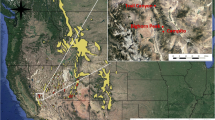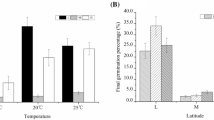Abstract
Plant species are shifting their ranges in response to global climate change, thus intensifying the need to predict such changes accurately. As the environmental requirements controlling plant distribution act differently at each developmental stage, there is a need to acquire a demographic-specific understanding of the factors which determine these distributions. Here we investigated the germination niche of two common savanna species Acacia nigrescens and Colophospermum mopane, with the aims to disentangle the direct and indirect effects of temperature on seed germination and establishment and to explore the impact of higher temperatures on the establishment success of savanna trees. Under laboratory conditions, we used thermal gradient plates to determine the thermal germination niche of both species, and a water stress experiment was conducted on C. mopane to account for water–temperature interactions. Using these data we parameterised a soil-moisture model to determine germination and establishment success under field conditions at current and future temperatures (+4 °C). Based on this model, higher future temperatures will not limit germination directly, but they will reduce the number of germination events by reducing the time window of suitable available soil water. Conversely, warmer conditions will accelerate the rate of radicle extension and increase the frequency of seedling establishment events. An additional advantage of higher temperatures is that fewer seeds will germinate, resulting in slower seed bank depletion when successful seedling establishment events do occur.






Similar content being viewed by others
References
Baskin CC, Baskin JM (1998) Seeds: ecology, biogeography, and evolution of dormancy and germination. Academic press, San Diego
Bierhuizen JF, Wagenvoort WA (1974) Some aspects of seed germination in vegetables. 1. The determination and application of heat sums and minimum temperature for germination. Sci Hortic 2:213–219
Botha S (2006) The influence of rainfall variability on savanna tree seedling establishment. Unpublished Msc thesis. Department of Botany, University of Cape Town, Cape Town
Bradford K (1990) A water relations analysis of seed germination rates. Plant Physiol 94:840–849
Bradford KJ (1995) Water relations in seed germination. In: Kigel J, Galili G (eds) Seed development and germination. Marcel Dekker, New York
Bradford KJ (2002) Applications of hydrothermal time to quantifying and modeling seed germination and dormancy. Weed Sci 50:248–260
Brown NAC, Van Staden J (1997) Smoke as a germination cue: a review. J Plant Growth Regul 22:115–124
Burke A (2006) Savanna trees in Namibia—factors controlling their distribution at the arid end of the spectrum. Flora-Morphol Distrib Funct Ecol Plants 201:189–201
Chesterfield CJ, Parsons RF (1985) Regeneration of three tree species in arid south-eastern Australia. Aust J Bot 33:715–732
Chidumayo EN (2008) Implications of climate warming on seedling emergence and mortality of African savanna woody plants. Plant Ecol 198:61–71
Choinski JS, Tuohy JM (1991) Effect of water potential and temperature on the germination of four species of African savanna trees. Ann Bot- 68:227–233
Cochrane A, Daws MI, Hay FR (2011) Seed-based approach for identifying flora at risk from climate warming. Austral Ecol 36:923–935
Covell S, Ellis RH, Roberts EH, Summerfield RJ (1986) The influence of temperature on seed germination rate in grain legumes I. A comparison of chickpea, lentil, soyabean and cowpea at constant temperatures. J Exp Bot 37:705–715
Daws MI, Lydall E, Chmielarz P, Leprince O, Matthews S, Thanos CA, Pritchard HW (2004) Developmental heat sum influences recalcitrant seed traits in Aesculus hippocastanum across Europe. New Phytol 162:157–166
De Villalobos AE, Peláez DV (2001) Influences of temperature and water stress on germination and establishment of Prosopis caldenia Burk. J Arid Environ 49:321–328
Donohue K, Rubio de Casas R, Burghardt L, Kovach K, Willis CG (2010) Germination, postgermination adaptation, and species ecological ranges. Annu Rev Ecol Syst 41:293–319
Edkins MT, Kruger LM, Harris K, Midgley JJ (2008) Baobabs and elephants in Kruger National Park: nowhere to hide. Afr J Ecol 46:119–125
Engelbrecht FA, McGregor JL, Engelbrecht CJ (2009) Dynamics of the conformal-cubic atmospheric model projected climate-change signal over southern Africa. Int J Climatol 29:1013–1033
Engelbrecht FA, Landman WA, Engelbrecht CJ, Landman S, Bopape M, Roux B, McGregor JL, Thatcher M (2011) Multi-scale climate modelling over Southern Africa using a variable-resolution global model. Water SA Manuscript. South African Water Research Commission, Rietfontein, Pretoria, vol. 37:647–658
Everitt JH (1983) Seed germination characteristics of two woody legumes (retama and twisted acacia) from south Texas. J Range Manag 36:411–414
February EC, Higgins SI (2010) The distribution of tree and grass roots in savannas in relation to soil nitrogen and water. S Afr J Bot 76:517–523
Felippe GM, Silva JCS (1984) Estudos de germinação em espécies do cerrado. Rev Bras Bot 7:157–163
Fenner M, Thompson K (2005) The ecology of seeds. Cambridge University Press, Cambridge
Foden W, Midgley GF, Hughes G, Bond WJ, Thuiller W, Hoffman MT, Kaleme P, Underhill LG, Rebelo A, Hannah L (2007) A changing climate is eroding the geographical range of the Namib Desert tree Aloe through population declines and dispersal lags. Divers Distrib 13:645–653
Gaston KJ (2009) Geographic range limits of species. Proc R Soc Edinburgh B 276:1391–1393
Gummerson RJ (1986) The effect of constant temperatures and osmotic potentials on the germination of sugar beet. J Exp Bot 37:729–741
Hardegree SP (2006) Predicting germination response to temperature. I. Cardinal-temperature models and subpopulation-specific regression. Ann Bot 97:1115–1125
Hardegree SP, Emmerich WE (1990) Partitioning water potential and specific salt effects on seed germination of four grasses. Ann Bot 66:587–595
Harrington GN (1991) Effects of soil moisture on shrub seedling survival in semi-arid grassland. Ecology 72:1138–1149
Heikkinen RK, Luoto M, Araújo MB, Virkkala R, Thuiller W, Sykes MT (2006) Methods and uncertainties in bioclimatic envelope modelling under climate change. Prog Phys Geogr 30:751–777
Henning AC, White RE (1974) A study of the growth and distribution of Colophospermum mopane (Kirk ex benth.) Kirk ex J. Leon: the interaction of nitrogen, phosphorus and soil moisture stress. Proc Grassl Soc S Afr 9:53–60
Higgins SI, Bond WJ, Trollope WS (2000) Fire, resprouting and variability: a recipe for grass–tree coexistence in savanna. J Ecol 88:213–229
Hoffman MT, Cowling RM, Doule C, Pierce SM (1989) Seed predation and germination of Acacia erioloba in the Kuiseb River Valley, Namib Desert. S Afr J Bot 55:103–106
Johnson JM, Pritchard J, Gorham J, Tomos AD (1996) Growth, water relations and solute accumulation in osmotically stressed seedlings of the tropical tree Colophospermum mopane. Tree Physiol 16:713–718
Jordaan A, Taylor JE, Rossenkhan R (2006) Occurrence and possible role of endophytic fungi associated with seed pods of Colophospermum mopane (Fabaceae) in Botswana. S Afr J Bot 72:245–255
Jurado E, Westoby M (1992) Germination biology of selected central Australian plants. Aust J Ecol 17:341–348
Kigerl J (1995) Seed germination in arid and semiarid regions. In: Kigel J, Galili G (eds) Seed development and germination. Marcel Dekker, New York
Knoop WT, Walker BH (1985) Interactions of woody and herbaceous vegetation in a southern African savanna. J Ecol 73:235–253
Kos M, Poschlod P (2010) Why wait? Trait and habitat correlates of variation in germination speed among Kalahari annuals. Oecologia 162:549–559
Kraaij T, Ward D (2006) Effects of rain, nitrogen, fire and grazing on tree recruitment and early survival in bush-encroached savanna, South Africa. Plant Ecol 186:235–246
Lambers H, Chapin FS, Pons TL (1998) Plant physiological ecology. Springer, Berlin
McInnes L, Purvis A, Orme CDL (2009) Where do species’ geographic ranges stop and why? Landscape impermeability and the Afrotropical avifauna. Proc R Soc Edinburgh B 276:3063–3070
McMahon SM, Harrison SP, Armbruster WS, Bartlein PJ, Beale CM, Edwards ME, Kattge J, Midgley G, Morin X, Prentice IC (2011) Improving assessment and modelling of climate change impacts on global terrestrial biodiversity. Trends Ecol Evol 26:249–259
Medina E, Silva JF (1990) Savannas of northern South America: a steady state regulated by water-fire interactions on a background of low nutrient availability. J Biogeogr 17:403–413
Michel BE (1983) Evaluation of the water potentials of solutions of polyethylene glycol 8000 both in the absence and presence of other solutes. Plant Physiol 72:66–70
Midgley JJ, Bond WJ (2001) A synthesis of the demography of African acacias. J Trop Ecol 17:871–886
Mlambo D, Nyathi P (2004) Seedling recruitment of Colophospermum mopane on the Highveld of Zimbabwe. South Afr For J 202:45–53
Mojeremane W, Kgati T (2005) Seed treatments for enhancing germination of Colophospermum mopane seeds: a multipurpose tree in Botswana. J Biol Sci 5:309–311
Nguyen A, Lamant A (1989) Variation in growth and osmotic regulation of roots of water-stressed maritime pine (Pinus pinaster Ait.) provenances. Tree Physiol 5:123–133
O’Connor TG (1995) Acacia karroo invasion of grassland: environmental and biotic effects influencing seedling emergence and establishment. Oecologia 103:214–223
Palgrave KC (2002) Trees of Southern Africa. Struik Publishers, Cape Town
Parmesan C (2006) Ecological and evolutionary responses to recent climate change. Annu Rev Ecol Syst 37:637–669
Parmesan C, Yohe G (2003) A globally coherent fingerprint of climate change impacts across natural systems. Nature 421:37–42
Pigott CD, Huntley JP (1981) Factors controlling the distribution of Tilia cordata at the northern limits of its geographical range III. Nature and causes of seed sterility. New Phytol 87:817–839
Pinheiro JC, Bates DM (2000) Mixed-effects models in S and S-PLUS. Statistics and computing. Springer, Berlin
Pinheiro J, Bates D, DebRoy S et al (2007) nlme: linear and nonlinear mixed effects models. R package version 3:1–89
Purves DW (2009) The demography of range boundaries versus range cores in eastern US tree species. Proc R Soc Edinburgh B 276:1477–1484
R Core Team (2012) R: A language and environment for statistical computing. R Foundation for Statistical Computing, Vienna, Austria. ISBN 3-900051-07-0. http://www.R-project.org/
Reason CJC, Hachigonta S, Phaladi RF (2005) Interannual variability in rainy season characteristics over the Limpopo region of southern Africa. Int J Climatol 25:1835–1853
Root TL, Price JT, Hall KR, Schneider SH, Rosenzweig C, Pounds JA (2003) Fingerprints of global warming on wild animals and plants. Nature 421:57–60
Rutherford MC, Midgley GF, Bond WJ (1999) South African Country study on climate change. Plant biodiversity: vulnerability and adaptation assessment. National Botanical Institute, Cape Town
Scholes RJ, Walker BH (1993) An African savanna: synthesis of the Nylsvley study. Cambridge University Press, Cambridge
Schulze RE (2007) South African atlas of climatology and agrohydrology. Report 1489/1/06 1489/1/06. Water Research Commission, Pretoria
Smith TM, Shackleton SE (1988) The effects of shading on the establishment and growth of Acacia tortilis seedlings. S Afr J Bot 54:375–379
Stevens N, Swemmer AM, Ezzy L, Erasmus BF (2014) Investigating potential determinants of the distribution limits of a savanna woody plant: Colophospermum mopane. J Veg Sci 25:363–373
Timberlake JR (1995) Colophospermum mopane: annotated bibliography and review. Zimbabwe Bull For Res No. 11, Harare
Wahid A, Gelani S, Ashraf M, Foolad MR (2007) Heat tolerance in plants: an overview. Environ Exp Bot 61:199–223
Walck JL, Hidayati SN, Dixon KW, Thompson KEN, Poschlod P (2011) Climate change and plant regeneration from seed. Glob Change Biol 17:2145–2161
Weiersbye IM, Witkowski ETF (2002) Seed fate and practical germination methods for 46 perennial species that colonize gold mine tailings and acid mine drainage-polluted soils in the grassland biome. Multiple use management of natural forests and woodlands: Policy refinements and scientific progress. Department of Water Affairs and Forestry of South Africa, Pretoria, pp 221–255
Wilson TB, Witkowski ETF (1998) Water requirements for germination and early seedling establishment in four African savanna woody plant species. J Arid Environ 38:541–550
Woodward FI (1987) Climate and plant distribution. Cambridge University Press, Cambridge
Acknowledgments
We thank the Seed Conservation Department of the Royal Botanic Gardens, Kew for hosting this work, and Anne Cochrane for putting us in contact with CES. Dr. Bob Scholes has assisted with the modelling methodology. This work received funding from the Andrew W. Mellon Foundation, UCT travel grants and CSIR Land–atmosphere feedback PG funding.
Author information
Authors and Affiliations
Corresponding author
Additional information
Communicated by Allan T. G. Green.
Electronic supplementary material
Below is the link to the electronic supplementary material.
Rights and permissions
About this article
Cite this article
Stevens, N., Seal, C.E., Archibald, S. et al. Increasing temperatures can improve seedling establishment in arid-adapted savanna trees. Oecologia 175, 1029–1040 (2014). https://doi.org/10.1007/s00442-014-2958-y
Received:
Accepted:
Published:
Issue Date:
DOI: https://doi.org/10.1007/s00442-014-2958-y




